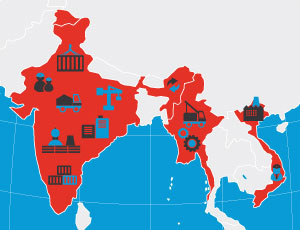Op-Ed Commentary: Chris Devonshire-Ellis
 May 4 – As it becomes apparent that China’s slowdown is to have a greater impact than originally thought this year, debate needs to be constructed concerning whether to just ride any downturn out or to be proactive and go looking for new markets and production centers. With several prominent China economists suggesting that China’s growth has flat-lined and given increasing costs in China, there is a need to consider other options. Here is an overview of India, Vietnam and Myanmar and what is happening in these different, yet rapidly-emerging markets.
May 4 – As it becomes apparent that China’s slowdown is to have a greater impact than originally thought this year, debate needs to be constructed concerning whether to just ride any downturn out or to be proactive and go looking for new markets and production centers. With several prominent China economists suggesting that China’s growth has flat-lined and given increasing costs in China, there is a need to consider other options. Here is an overview of India, Vietnam and Myanmar and what is happening in these different, yet rapidly-emerging markets.
India
Recent business media has painted a grim picture of developments in the country, but in reality there’s not much behind the hype. Businesses always like to throw tantrums when their toys are taken away, and the introduction of GAAR regulations – principally aimed at plugging the capital gains tax loophole that has made Mauritius India’s largest source of FDI – has had many screaming foul at the top of their lungs and suggesting all kinds of tax horrors will emerge. They won’t. Getting laws onto statute to ensure fair and even play is a totally different beast from knee jerk media reports that India will reassess tax liabilities going back to 1962. It’s absurd and untrue, and in any event, India’s statute of limitations is six years.
So India’s media hype is damaging how the actual investment environment is being perceived – in the world’s noisiest democracy it pays to look beyond the headlines. In fact, reform has been occurring, with single brand retail now permitted and other sectors for foreign investment opening up faster than expected.
However, the main driver for India – over and beyond any politics – remains its population dividend. With an average workforce age of 23, it is one of the youngest countries in the world and this massive population will sustain a boom in manufacturing for the next two decades just as China starts to age and become more expensive. That population is the key driver for India’s growth and is a key reason why manufacturing is starting to shift there. It is also the main driver behind an increasingly wealthy middle class.
Continue reading this article on China Briefing News.


